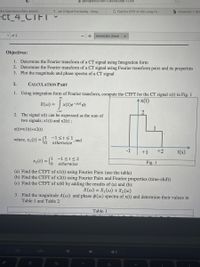
Introductory Circuit Analysis (13th Edition)
13th Edition
ISBN: 9780133923605
Author: Robert L. Boylestad
Publisher: PEARSON
expand_more
expand_more
format_list_bulleted
Question
I need help solving calculation part 1. Please include steps and descriptions

Transcribed Image Text:I geórgiasouthern.desire2learn.com
ttps://georgiasouthern.desire2.
G Lab 4 Signal Processing - Goog..
G Find the CTFT of x1(t) using Fo...
b Answered: 1. Det
ect_4_CTFT
1 of 2
+ Automatic Zoom
Objectives:
1. Determine the Fourier transform of a CT signal using Integration form
2. Determine the Fourier transform of a CT signal using Fourier transform pairs and its properties
3. Plot the magnitude and phase spectra of a CT signal
I.
CALCULATION PART
1. Using integration form of Fourier transform, compute the CTFT for the CT signal x(t) in Fig. 1
|x(t)
X(@) =
| x(t)e-jwt dt
2. The signal x(t) can be expressed as the sum of
two signals; x1(t) and x2(t) ;
x(t)=x1(t)+x2(t)
-1<t<1
where, x, (t) =
otherwise and
-1
+1
+2
t(s)
-1 <t<2
otherwise
x2(t) =
Fig. 1
(a) Find the CTFT of x1(t) using Fourier Pairs (use the table)
(b) Find the CTFT of x2(t) using Fourier Pairs and Fourier properties (time-shift)
(c) Find the CTFT of x(t0 by adding the results of (a) and (b):
X (@) = X,(w) + X2(@)
3. Find the magnitude A(@) and phase (w) spectra of x(t) and determine their values in
Table 1 and Table 2
Table 1
24
Expert Solution
This question has been solved!
Explore an expertly crafted, step-by-step solution for a thorough understanding of key concepts.
Step by stepSolved in 2 steps with 2 images

Knowledge Booster
Learn more about
Need a deep-dive on the concept behind this application? Look no further. Learn more about this topic, electrical-engineering and related others by exploring similar questions and additional content below.Similar questions
- MULTIPLE CHOICE -The answer is one of the options below please solve carefully and circle the correct option Please write clear .arrow_forwardModule 10 Section Review 3.0.0.png Additional Resources Electronics Fundamentals: Circuits, Devices, and Applications, Principles of Electric Circuits, Thomas L. Floyd. New York: Prent 3.0.0 Section Review 1. The letter designation SL on an electrical draw- ing indicates a 4. A a. a. limit switch b. low-voltage switch c. load switch d. light switch b. C. d. 2. Existing power lines on an electrical site plan may be indicated by the letter 5. In t safe a. E b. I a. b. 2 С. Р d. V C. 2 d. 2: 3. The specific types of luminaires required in an installation can be found on the a. power plan b. electrical site plan c. schematic diagram d. lighting fixture schedule P Search for anythingarrow_forwardPlease click on pic to open itarrow_forward
- 1-What phrase is used when a substitution is permitted for a specific item? 2-The specifications state that all work shall be done... 3-What phrase is used when a substitution is permitted for a specific item? 4-What is the purpose of an electrical symbol? 5. Where are notations found?arrow_forwardInstruction: Identify the parts/components as illustrated in the pictures and write down the corresponding letter of each function written below: Computer Standard Parts: Funtions: A. A device that sends information to a computer system for processing. B. Control instructions and data flow to and from other parts of the computer. It is the heart and brain of a computer. 1. 2. C. It execute the instructions, control storage data and input or output devices attached the computer. Basic Components: D. A printed circuit board that is the foundation of a computer and is considered to be the backbone of the computer. E. Reproduces or displays the results of that processing. 3. 4. Name of Parts/Components Corresponding Function Letter / (yes), X (no) / (yes), X (no) 1. 2. 3. 4. 5.arrow_forwardAnswer question clearly and fully. Make sure I can properly read out the steps. Include any and all equations used during the solving process.arrow_forward
arrow_back_ios
arrow_forward_ios
Recommended textbooks for you
 Introductory Circuit Analysis (13th Edition)Electrical EngineeringISBN:9780133923605Author:Robert L. BoylestadPublisher:PEARSON
Introductory Circuit Analysis (13th Edition)Electrical EngineeringISBN:9780133923605Author:Robert L. BoylestadPublisher:PEARSON Delmar's Standard Textbook Of ElectricityElectrical EngineeringISBN:9781337900348Author:Stephen L. HermanPublisher:Cengage Learning
Delmar's Standard Textbook Of ElectricityElectrical EngineeringISBN:9781337900348Author:Stephen L. HermanPublisher:Cengage Learning Programmable Logic ControllersElectrical EngineeringISBN:9780073373843Author:Frank D. PetruzellaPublisher:McGraw-Hill Education
Programmable Logic ControllersElectrical EngineeringISBN:9780073373843Author:Frank D. PetruzellaPublisher:McGraw-Hill Education Fundamentals of Electric CircuitsElectrical EngineeringISBN:9780078028229Author:Charles K Alexander, Matthew SadikuPublisher:McGraw-Hill Education
Fundamentals of Electric CircuitsElectrical EngineeringISBN:9780078028229Author:Charles K Alexander, Matthew SadikuPublisher:McGraw-Hill Education Electric Circuits. (11th Edition)Electrical EngineeringISBN:9780134746968Author:James W. Nilsson, Susan RiedelPublisher:PEARSON
Electric Circuits. (11th Edition)Electrical EngineeringISBN:9780134746968Author:James W. Nilsson, Susan RiedelPublisher:PEARSON Engineering ElectromagneticsElectrical EngineeringISBN:9780078028151Author:Hayt, William H. (william Hart), Jr, BUCK, John A.Publisher:Mcgraw-hill Education,
Engineering ElectromagneticsElectrical EngineeringISBN:9780078028151Author:Hayt, William H. (william Hart), Jr, BUCK, John A.Publisher:Mcgraw-hill Education,

Introductory Circuit Analysis (13th Edition)
Electrical Engineering
ISBN:9780133923605
Author:Robert L. Boylestad
Publisher:PEARSON

Delmar's Standard Textbook Of Electricity
Electrical Engineering
ISBN:9781337900348
Author:Stephen L. Herman
Publisher:Cengage Learning

Programmable Logic Controllers
Electrical Engineering
ISBN:9780073373843
Author:Frank D. Petruzella
Publisher:McGraw-Hill Education

Fundamentals of Electric Circuits
Electrical Engineering
ISBN:9780078028229
Author:Charles K Alexander, Matthew Sadiku
Publisher:McGraw-Hill Education

Electric Circuits. (11th Edition)
Electrical Engineering
ISBN:9780134746968
Author:James W. Nilsson, Susan Riedel
Publisher:PEARSON

Engineering Electromagnetics
Electrical Engineering
ISBN:9780078028151
Author:Hayt, William H. (william Hart), Jr, BUCK, John A.
Publisher:Mcgraw-hill Education,